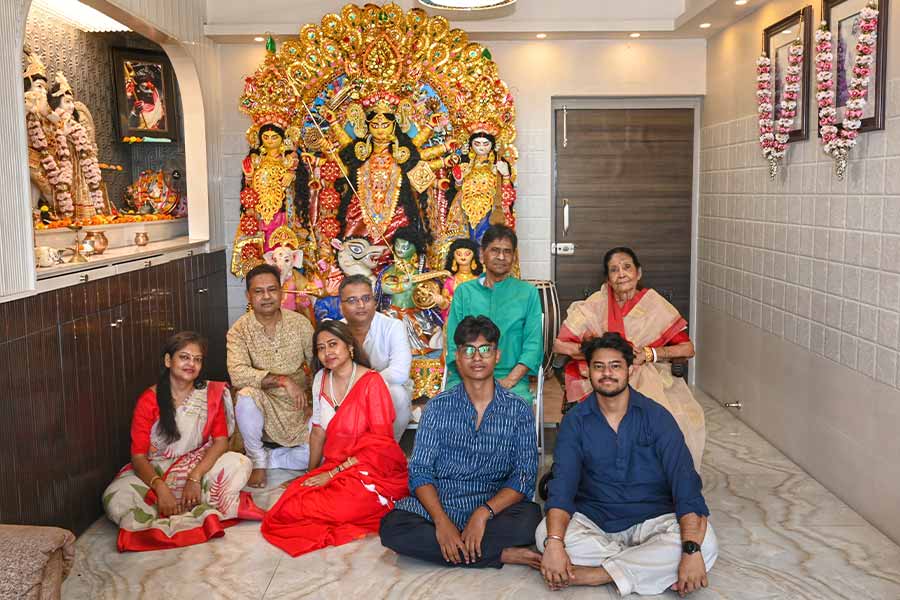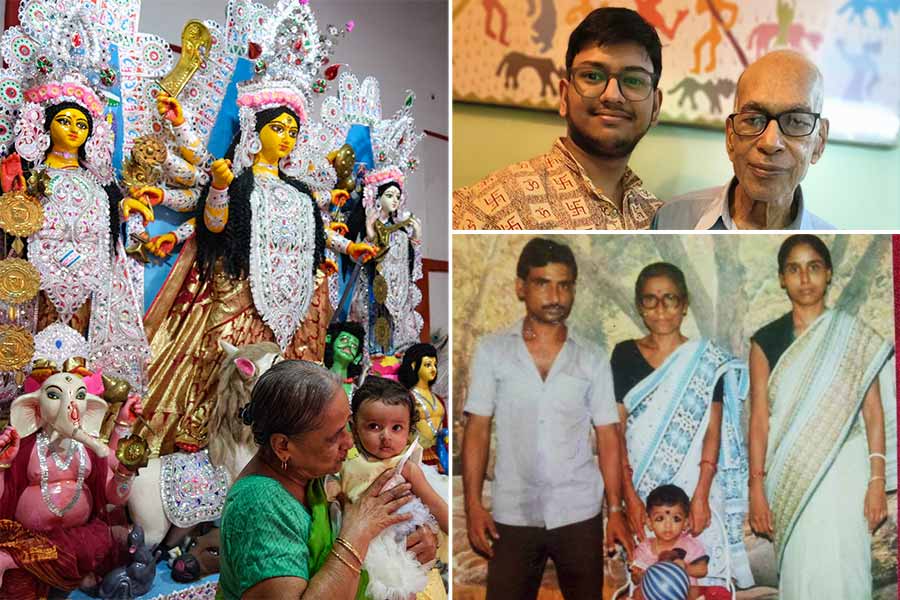All family pujas have rituals unique to them but a Durga puja where the rituals influenced by Tantric Buddhism is one of a kind. The Chatterjee family of Patuligram or Patuli in Hooghly district has its own religious scripture.
The puja is held in a flat-roofed covered Durga dalan (courtyard) with a small corridor having a triple-arched entrance and a flight of stairs. Locally, this structure is known as Moth Bari and the goddess as Moth-er Ma.

The flat-roofed Durga ‘dalan’, renovated in 1900, is said to have been a Buddhist ‘moth’ or monastery some 300 years ago Shrabanti Mitra
Patuligram is located near Saptagram-Tribeni-Katwa road, also known as state highway 6, close to Jirat railway station. The village is said to have been a seat of Buddhist culture several hundred years ago.
Family member Anirban Chatterjee said there are two theories about the family’s place of origin. One theory is that they were Brahmins who came from ancient Patna or Pataliputra, which is why the village was originally known as Aayma Patuli and the name later changed to Patuligram or Patuli. The other theory is that they were Brahmins from Kannauj. For several years, Rarh Brahmin families have been residing in this place and its surrounding locality.
The Chatterjee family tree says that Madanmohan Tarakalankar (not be confused with the legendary social reformer by the same name), a learned saint who belonged to this family, arrived in Jirat close to the middle of 17th century and started meditating inside this moth, which then lay in ruins. Soon, he became well- known and the maharaja of Nadia allocated the village Aayma Patuli to him. Tarakalankar started living here after building a residential place besides the structure. Divine intervention led him to start Durga puja here following tantric rituals.
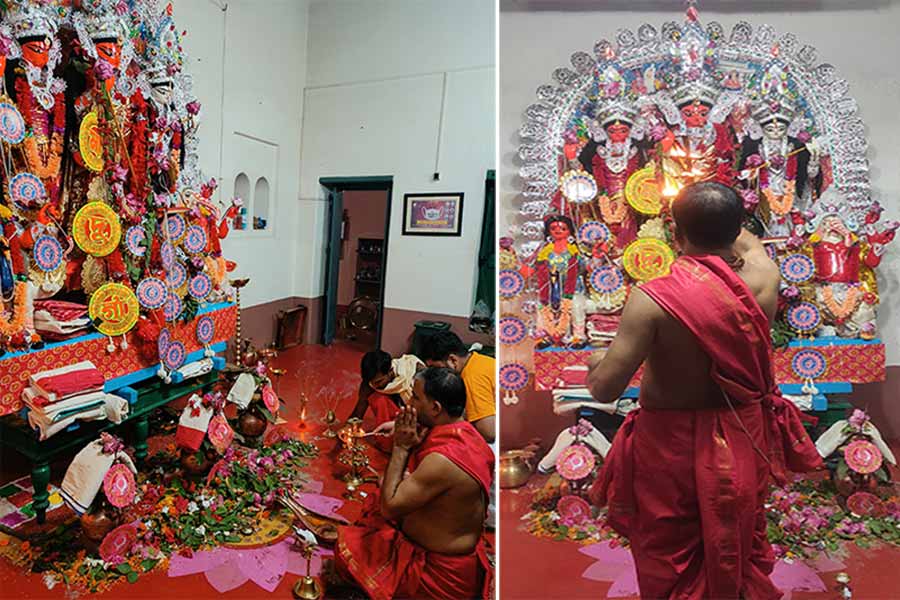
According to the family members, there are several rituals in the Durga Puja of ‘Moth Bari’, which has a touch of Tantric Buddhism Chatterjee family of Moth Bari Patuli
Binoy Ghosh, in his book Paschimbanger Sanksriti (Part 3), wonders if the name Patuli came from Pataliputra. He also writes that in all probability, the ancestors of the Chatterjee family followed Buddhist tantric rituals and so they chose a Buddhist moth or monastery as their place of worship. He believes that the flat- roofed structure where Durga puja takes place now was probably earlier a moth or a monastery.
The flat-roofed covered structure looks nothing like a Buddhist monastery now. The building was in shambles till the family members renovated it in 1900 and gave the structure its present shape. The year of renovation is engraved on its top in its corresponding Bengal version (1307).
Two ancient white statues of Gautam Buddha in Bhumisparsha Mudra have been in possession of the Chatterjees since long. They are kept inside the Durga dalan, each placed inside a kulungi (niche).
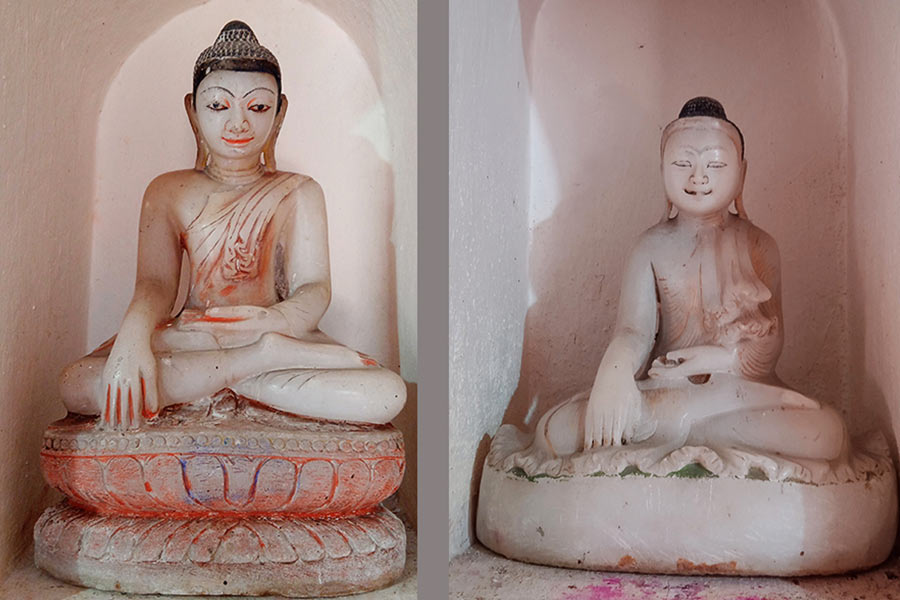
The Chatterjee family is in possession of these two age-old white statues of Gautam Buddha, which reside inside the Durga ‘dalan’ Photo: Amitabha Gupta
Anirban said there are several rituals in the Durga puja that definitely have a touch of Tantric Buddhism. He said the family priest says the scriptures do have some similarity with Brihat Nandikesar Puran.
The Durga idol is unique, too, with only two prominent hands in front. The remaining hands are very small (almost the size of a finger) and positioned at the back. When the deity is fully decorated, only the two hands are visible. The rest remain hidden behind the hair of the goddess. The skin colour of the deity is what the purists call taptakanchanbarna, which implies the colour of the stem of shiuli flower. The goddess is draped in a red sari and decked out in silver foil (daaker saaj) with a few gold ornaments. The sword of the goddess and the asura are made of brass. Interestingly, instead of the conventional position, Ganesh stands to the left of the goddess and Kartik to the right. The lion is horse-faced as seen in old traditional houses of West Bengal.
Kathamo puja of the deity is conducted on the day of Janmashtami. Bodhon takes place on Sasthi. Nabapatrika rituals are a private affair and take place inside the house.
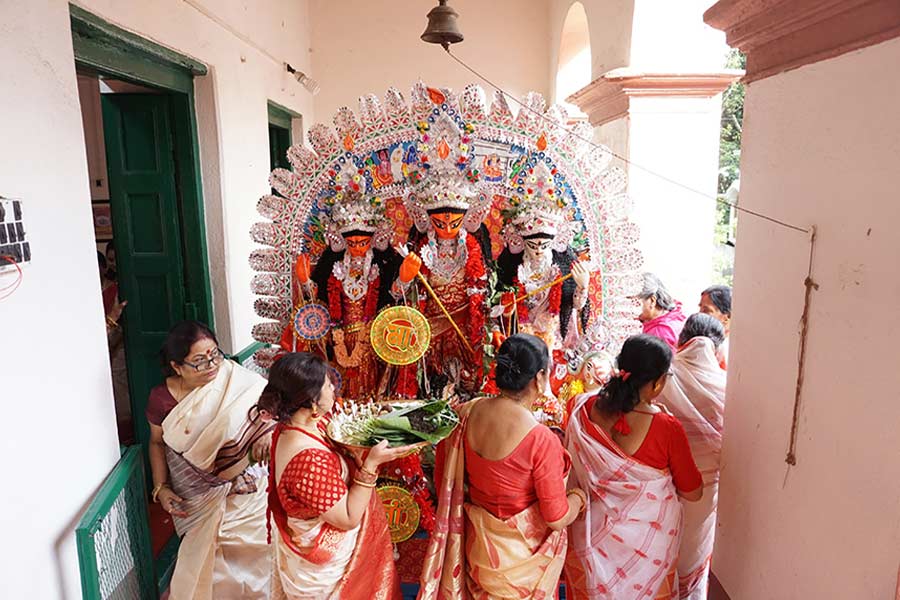
Durga ‘boron’ on Bijoya Dashami at Moth Bari Patuli Chatterjee family of Moth Bari Patuli
There is no Sandhi Puja at the Moth Bari Durga Puja but an Ardha Ratri puja which takes place between Saptami and Ashtami for two to three hours. A part of the puja involves inviting Dakini and Yogini. After the end of that puja, a sacrifice takes place. It is said that earlier human sacrifice used to take place in this place but was abolished ages ago. It was replaced by animal sacrifice, which has been discontinued too. Now, a human effigy made of rice grains is sacrificed. The effigy is cut into several pieces and offered to 64 yoginis with mashkalai dal and doob grass. Thereafter, 108 brass lamps are lit for the goddess.
Binoy Ghosh, in his book Paschimbanger Sanksriti (Part 3), and Sudhir Kimar Mitra in Hooghly Jelar Itihas o Banga Samaj (Part 2), have mentioned about possibilities of human sacrifice in earlier days in this puja.
The bhog or food offering to the goddess is very simple and not as grand as in other traditional houses. It comprises Gobindobhog rice, moong dal, arhar dal, fried vegetables, pumpkin curry, a preparation of lau (bottle gourd), payesh and tamarind chutney. One preparation is common on all three days — kochur shaak. On Ashtami, chutney made of chalta (elephant apple) is served.

Twenty-odd people dedicatedly carry the goddess at Moth Bari Patuli on Bijoya Dashami Chatterjee family of Moth Bari Patuli
Anirban explained why the food offering is so simple. “The goddess had said to Madanmohan in his dreams that she is placed elsewhere and wished to be worshipped at his place. Madanmohan said he was poor and not a zamindar and could not afford to feed a goddess. The divine entity replied that she would eat simple food and in small quantities. She emphasised that she would eat with two hands only and not with 10 hands, the reason behind the deity having two normal hands, with the rest eight being very small.”
Sindoor Khela is a private affair where womenfolk of the house put vermillion on the foreheads and cheeks of each other. The goddess is immersed in the Ganga after 20-odd people carry her over 4km to Balagarh Ghat. There are several stops on the way as womenfolk of many households perform the rituals of boron.
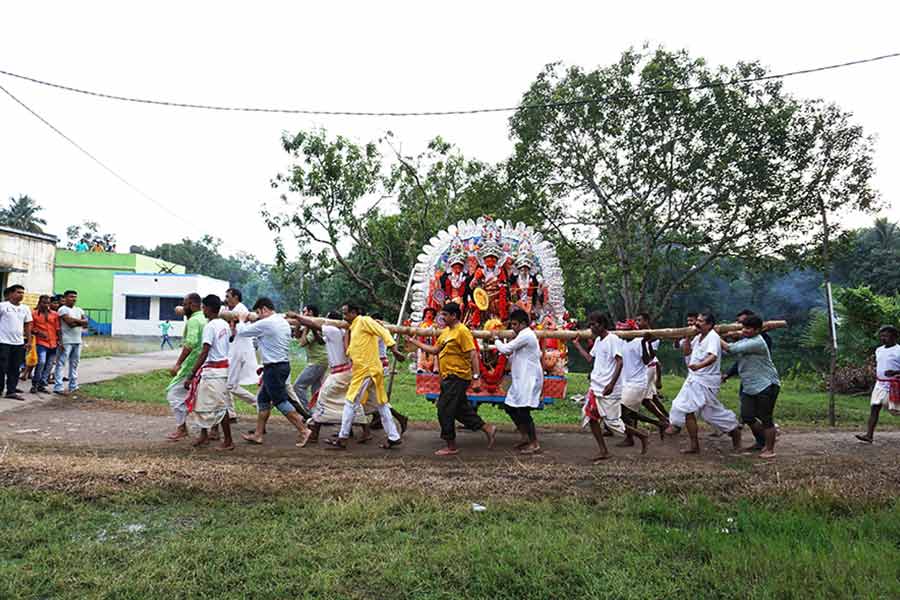
The goddess at Moth Bari Patuli is carried manually over 4km before her immersion from boats which leave from Balagarh Ghat Photo: Chatterjee family of Moth Bari Patuli
The goddess is taken into boats at Balagarh Ghat and immersed after making seven rounds in the river. The arrangement of the boats and their payment is not made by the Chatterjee family, but the Manna family who stay close to Balagarh Ghat.
The puja conducted by the Chatterjee family at present was originally conducted by the Manna family several hundred years ago. Legend goes that one night, the senior-most member of the Manna family had a dream that a woman with two children was requesting entry into the house. Being ill, he could not open the door. The lady then said: “I am leaving this house for another house. She gave a description of her destination and asked him to pay the fare of the boat as she did not have any money.”

There are several stops on way to immersion as womenfolk of many households perform ‘boron’ rituals for the goddess Photo: Chatterjee family of Moth Bari Patuli
On waking up in the morning, senior Manna decided to look out for the house described by the goddess in his dreams. After locating the house of the Chatterjee family in Patuli, to his surprise he found that Madanmohan Tarakalankar also had a dream about the goddess showing interest to be worshipped at his place.
Since then though the Durga puja takes place at the house of the Chatterjees, the immersion costs are borne by the Manna family following the request of the goddess made nearly over 350 years ago.


